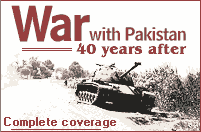The Indian Air Force played a key role in the 1965 conflict. As part of our special series to mark the 40th year since that war, we bring you two excerpts from a seminal book on the subject, The India-Pakistan Air War of 1965, by PVS Jagan Mohan and Samir Chopra.
By the morning of September 9th, the battle at Khem Karan had started. A mixed formation of 7 and 27 Squadron Hunters led by Squadron Leader Bishnoi was detailed for close support and interdiction.
Bishnoi's No. 2 was Flight Lieutenant Gurbux Singh Ahuja. The second section consisted of Flight Lieutenant SK Sharma of 7 Squadron and Flying Officer DK Parulkar.
 The four Hunters arrived at Kasur at low level. Noticing dust raised by the movement of a heavy armoured column, Bishnoi alerted the formation and the Hunters switched on their electricals to arm their rockets. As they reached their target, the anti-aircraft fire from the heavy 40-mm machineguns on the tanks greeted them. Bishnoi led the first attack.
The four Hunters arrived at Kasur at low level. Noticing dust raised by the movement of a heavy armoured column, Bishnoi alerted the formation and the Hunters switched on their electricals to arm their rockets. As they reached their target, the anti-aircraft fire from the heavy 40-mm machineguns on the tanks greeted them. Bishnoi led the first attack.
He pulled up to 300 feet and rolled into a dive onto a cluster of three tanks. His salvo of eight rockets had immediate effect: as he pulled away from the target, three tanks could be seen burning. Ahuja and Sharma followed with rocket attacks on tank targets. They accounted for several tanks and armoured personnel carriers as well as soft skinned vehicles. The Hunters made repeated passes flying through the wall of flak till they had expended all their rockets and front gun ammunition.
The last to dive into the attack was the No.4, Parulkar. His Hunter faced the concentrated fire of the AA machine guns of the tanks, which had by then found time to correct and coordinate their fire.
Just into the dive, Parulkar's Hunter was hit. The first thing Parulkar noticed was the explosive decompression as a bullet pierced the pressurized cockpit. The bullet pierced the floor of the cockpit, traveled up and through Parulkar's right arm, through the seat's headrest and finally made a hole in the Plexiglas canopy.
Parulkar was lucky. He was crouching to the front to peer thru the gunsight when the bullet went through his headrest, otherwise his head would have been in the path of the bullet. The resultant depressurization misted the cockpit obscuring visibility. Since there was a hole in the canopy the airstream cleared the condensation on the windscreen. Parulkar continued the attack and fired off his rocket salvo at the tanks.
As he pulled out of the attack, Parulkar felt sharp pain in his arm and felt his flying suit being soaked with blood. He decided not to report it to Bishnoi, sensing the attack might be aborted if he told Bishnoi that he was wounded. Bishnoi by then had expended his second salvo of rockets on other tanks and commenced gun attacks on soft skinned vehicles.
At the end of his fourth pass, Bishnoi called for the formation to assemble for the flight back.
On exiting the target area, Parulkar radioed Bishnoi and informed him that he had been hit in his right arm by ground fire and was bleeding profusely. The rest of the formation was concerned: though Parulkar could fly back with one arm, he would need both to land. Bishnoi suggested that Parulkar eject over Indian territory. Parulkar refused, assuring Bishnoi that he would be able to land safely. The formation decided that Parulkar would land last so as to not block the runway if his landing failed.
Moments later Parulkar made his approach. Dizzy due to the loss of blood he carried out an overshoot and came around. He was able to land successfully during the second attempt. Ambulances and crash tenders approached his aircraft, but ignoring them, Parulkar taxied his Hunter to dispersal. Parulkar's overalls were drenched in blood. Still in extreme pain, he was rushed to the base hospital.
An inspection of Parulkar's Hunter revealed how lucky he had been. The bullet -- after striking Parulkar in the arm -- had gone through his headrest and through the top of the ejection seat, severely fraying the static line that connects the drogue parachute with the main parachute of the seat.
Had Parulkar fired the seat the main chute would not have deployed, as the static line would have severed with the force of the opening impact of the drogue chute. The seat would have dropped to the ground without the main chute deploying. Parulkar was ignorant of this damage, making his decision to attempt the landing even more commendable.
Excerpted with permission from The India Pakistan Air War of 1965, PVS Jagan Mohan and Samir Chopra, Manohar Books.





